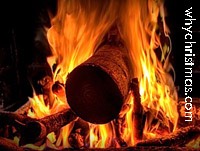Special Catholic feasts coincide with pagan holy days, and are celebrated in one form or another by most cultures.
For example, Lady Day is a Catholic feast celebrated on March 25. This is also the feast held in honor of the goddess of Cybele in ancient times.
The 25th of December, which we celebrate as Christmas, was the commemorative day of the birth of the sun god.
The Christmas Tree

When Nimrod was destroyed, he was symbolized as the tree that was cut off. To this day, his rebirth is celebrated as the new branch (Christmas tree) that sprouts from the sawed-off stump through the life-giving power of the serpent. The ancient practice of celebrating the birth of the sun god through the fir tree is found in most ancient religions, even those of the ancient Indian cultures of South America.i
In England, Christmas is celebrated by throwing the Yule log into the fire, representing the destruction of Nimrod. The Christmas tree was then decorated, symbolizing the rebirth of the sun god.
Animals
The sacrificial animals on this day were the unclean animals such as the pig and the goose. Both these animals are the main Christmas meal in European countries.
Santa Claus
Santa Claus has virtually replaced Jesus Christ as the main feature of Christmas. Santa rides across the skies in his reindeer-drawn chariot. He is made acceptable by his friendly appearance, but he has the same characteristics as the ancient sun deities:
The birth of Osiris, the Egyptian sun god, coincided with the day of solstice, and on this day he would ride through the heavens in his chariot.
The Greek sun god Helios would ride through the sky in his sun chariot drawn by horses as depicted in the great fountain of Versailles.
In the Hindu culture, the Sûrya and his charioteer Aruna rides across the sky in a horse-drawn sun chariot. In other cultures, animals such as the goat (Zeus) or the reindeer pull the chariot.
Origin of Santa Claus: 4th century: Historical evidence shows that St. Nicholas never existed as a human. He was rather a Christianized version of various Pagan sea gods —the Greek god Poseidon, the Roman god Neptune, and the Teutonic god Hold Nickar. In the early centuries of the Christian church, many Pagan gods and goddesses were humanized and converted to Christian saints. When the church created the persona of St. Nicholas, they adopted Poseidon’s title “the Sailor.” They picked up his last name from Nickar. Various temples of Poseidon became shrines of St. Nicholas.ii
Santa, as taught to most children, has the attributes of God:
1. He is virtually omnipresent. He can visit hundreds of millions of homes in one night.
2. He is omniscient. He monitors each child, he is all-seeing and all-knowing, and he knows when they are bad and good. He can manufacture gifts for hundreds of millions of children, and deliver them in one night—each to the correct child.
3. He is all-good and all-just. He judges which children have shown good behavior and rewards them appropriately. Bad children are bypassed or receive a lump of coal.
4. He is eternal.